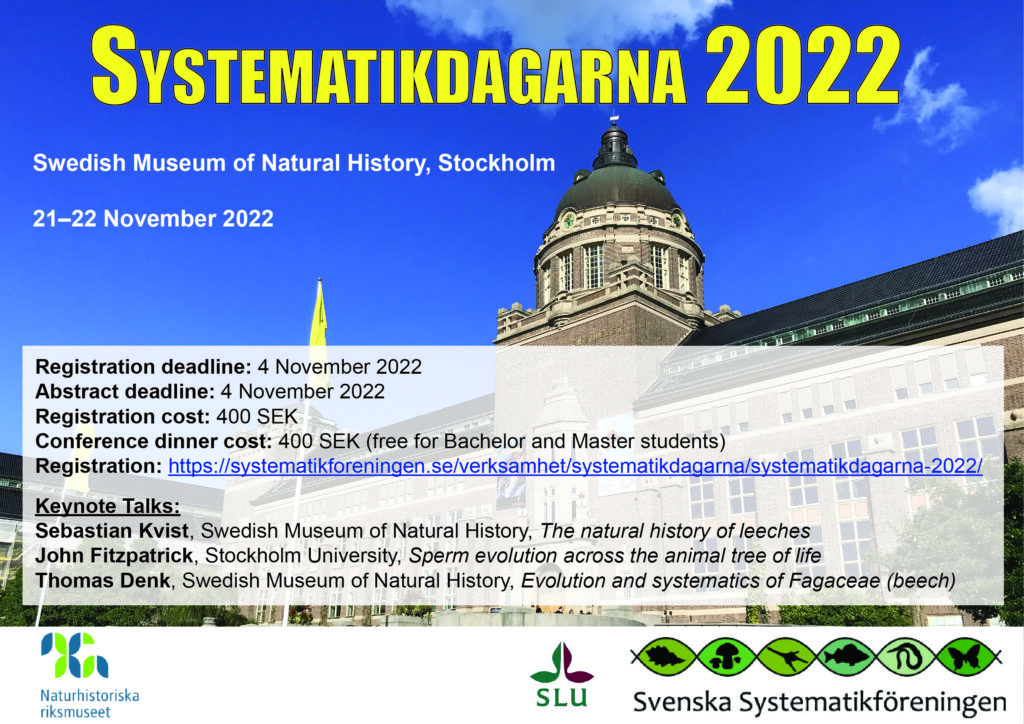Systematikdagarna 2022 will take place at Naturhistoriska riksmuseet (Swedish Museum of Natural History), November 21-22. Financial support to the meeting is generously provided by SLU Artdatabanken (SLU Swedish Species Information Centre).

Programme, practical information and abstract book
Programme and practical information to download (as a pdf file). Note: You will need to print your own copy if you want a schedule on paper!
Abstract book to download (pdf).
Keynote talks (abstracts below)
- Sebastian Kvist, Director of Science, Swedish Museum of Natural History, The natural history of leeches: evolution, blood and collections
- John Fitzpatrick, Stockholm University, Sperm evolution across the animal tree of life
- Thomas Denk, Swedish Museum of Natural History, Evolution and systematics of Fagaceae (the beech family): Integrating morphology, fossils and molecular phylogenies
Other highlights
- Prizes for best student talk and poster
- Glöggmingel in the Orangerie at the Bergianska Botanical Gardens
- Conference dinner at the Museum
Registration cost
After registration, you will receive an e-mail with payment instructions. The cost for participation in this year’s Systematikdagarna is:
- Full participation: 800 SEK per person, which includes conference fee, ”fika”, lunch and conference dinner in the evening of November 21.
- Limited participation: For those who do not wish to participate in the dinner, the conference cost is 400 SEK.
- Bachelor and Master students can register for 400 SEK (including dinner).
- You are also very welcome to pay the yearly membership fee to Svenska Systematikföreningen (100 SEK). Check the correct box in the registration form and add the appropriate amount to the conference fee when paying. You can also pay the membership fee separately.
More about membership in Svenska Systematikföreningen and how we handle your personal information.
Registration
Please use the registration form. Deadline was November 4.
Location
- Naturhistoriska riksmuseet (Swedish Museum of Natural History)
- Frescativägen 40, Stockholm
- T-bana (Metro): Universitetet
Keynote talk abstracts
The natural history of leeches: evolution, blood and collections
Sebastian Kvist, Director of Science, Swedish Museum of Natural History
I will present two central themes in this talk. The first focuses on the research and ongoing work to enhance the collections at the Swedish Museum of Natural History. In this context, I will provide an overview of the current state and provide a vision for the future. In the second theme, I will provide a background of my own research into the evolution of blood feeding in leeches, which entails collection-based strategies coupled with deep sequencing. Results suggest that ancestral leeches were indeed capable of anticoagulation and that blood feeding as a strategy has been lost on several occasions over the millions of years of evolution that the group has undergone. I discuss the implications of this from the perspective of both leech natural history and the medical applications of these charismatic critters.
Sperm evolution across the animal tree of life
John Fitzpatrick, Department of Zoology, Stockholm University
Explaining the extraordinary morphological diversity of sperm – the most diverse cell type known – has been a major goal of evolutionary biologists for more than a century. Male-male competition, female-sperm interactions and variation in fertilization environments are commonly hypothesized to be key selective forces shaping sperm evolution. However, most studies examining sperm evolution focus at the clade, family or genus level. Consequently, our understanding of the factors shaping sperm evolution across the animal tree of life remains limited. In this talk, I draw on examples spanning the animal tree of life to describe a general framework for understanding sperm evolution. I show that sperm competition, an extended for of male-male competition that occurs after mating, and female-sperm interactions, which allow females to exert selection on sperm after mating, are key drivers of sperm morphological diversification. However, the way that sperm competition and female-sperm interactions influence sperm evolution changes following evolutionary transitions in fertilization environments, from external to internal fertilization. I argue that evolutionary transitions to internal fertilization supercharge sperm evolution by increasing the scope for female-sperm interactions and changing the rules for how sperm compete to fertilize eggs. Using this novel framework, we can make sense of sperm diversity across the animal tree of life and can even explain cases of sperm ‘gigantism’. Together, this work highlights that understanding sperm evolution requires careful consideration of female reproductive biology.
Evolution and systematics of Fagaceae (the beech family): Integrating morphology, fossils and molecular phylogenies
Thomas Denk, Swedish Museum of Natural History
The plant family Fagaceae (the beech family) comprises 10 extant genera and about 1,000 tree species with a wide distribution across the Northern Hemisphere and range extensions into the Southern Hemisphere. Fagaceae have been extensively studied using phylogenomic analyses and intra-familial relationships are now well understood. These phylogenetic frameworks of extant taxa are crucial for the study of character evolution and identifying phylogenetically informative morphological characters back through time. Applied to the rich fossil record they allow us to trace evolutionary histories of individual members of Fagaceae. I will summarize currently available evidence for Cenozoic radiations of modern Fagaceae during the past 66 million years using the fossil records of dispersed pollen and other reproductive structures, and leaf fossils. I will also discuss some recent biogeographic ideas about northern versus southern hemispheric dispersal routes of Fagaceae.

